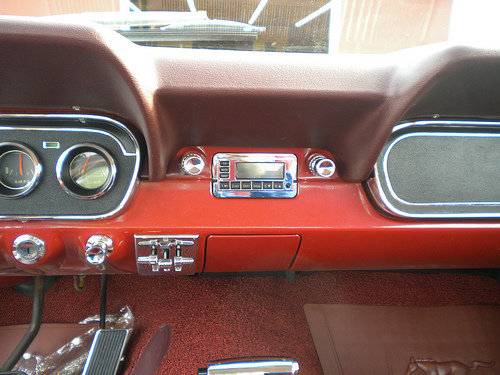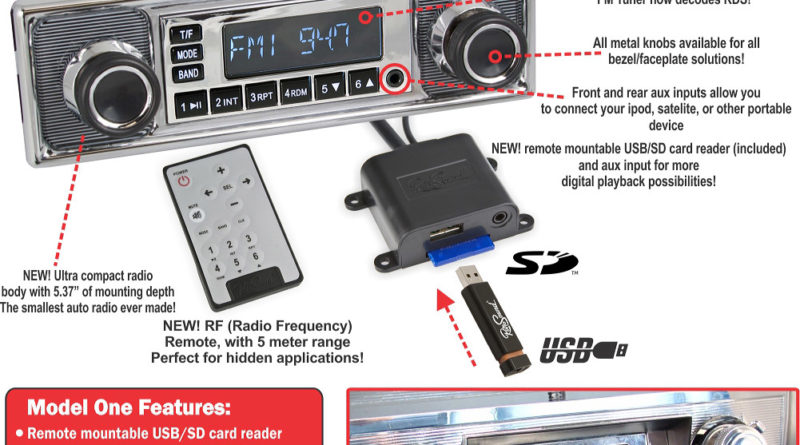RetroSound Model One Classic Head Unit
Product Details
Manufacturer: RetroSound
Distributor: Autosound Ltd
Website: link
Typical Selling price: £199.99 to £219.00 depending upon panel and knobs
What It Is
Are you familiar with the Chrysler PT Cruiser, or the later Crossfire? They look all retro by bodywork but are modern cars underneath. (Well, a few years old now) What we have here is an AM/FM radio that looks like an old fashioned ‘˜Spindle’ mount radio but which behind the panel is bang up to date. This was the standard format before the rectangular hole that we call single DIN. It is the DIN cage itself that supplies the support for the unit in this current morphology but Spindle mount cars would have metal flanges of great strength as part of the car’s metalwork to hold the radio in place by its two spindles. What RetroSound (an American outfit) have done is to create a system they call ‘˜InfiniMount’ for which a patent is pending, that allows mounting their Spindle-style unit in more flexible ways than have ever been seen in car electronics. The ‘˜Spindles’ are in fact separate items that have each got a four-wire Molex connector and plug into the side of the small radio-electronics unit. They then bolt into the InfiniMount brackets where ever they need to be put. The unit’s nose can also be unbolted and there is a three inch ribbon cable joining the display to the electronics, so you can even mount it in places where there is no room behind the dash.
Also, and somewhat incredibly, as I looked for the tell-tale Infra-Red ‘˜Eye’ needed to use a remote control and failed to find it, I discovered that the remote control is Radio Frequency not Infra Red. So, as long as you don’t lock the unit inside a metal case behind the dash, you could even hide the radio completely and have the remote control in your hand for a totally stealthy, unseen installation. This RF remote is as rare as hen’s teeth in car audio.
That said, the page from the USA site here: link has over a hundred types of old cars’ installation looks photographed with the panels and knobs they need. The weirdest is this one, for the ’63 to ’67 Corvette, which really shows flexibility!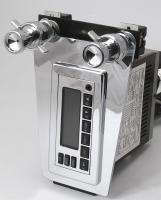
But for UK buyers, the page on the UK site here is what you need: link it offers six combinations of panel and plates covering chrome effect, ivory look, black, Blaupunkt or Becker style knobs and black and chrome panels in shapes to fit the dash of classic Volkswagens and even the curvy Karmann Ghia panel. And having felt and hefted the bits, I can tell you that they are heavy cast-metal knobs that feel solid and utterly retro, be they black or chrome and that the front plates are high quality and solidly made.
Full Specifications
Small format car radio with remote control and wired SD card reader/aux input unit
Main ‘˜nosecone’ unit available in Black or Chrome
Output power @ 14.4V, @ 4Ohms, @1%THD 50w x 4 MOSFET amplifier on board (100w x 4 Max Power)
Front and Rear AUX input
AM/FM Tuner with 30 presets and RDS
Small chassis size (under 135mm mounting depth)
4 RCA (phono) output for external amplification or subwoofer
LCD Display with wide viewing angle
Supplied with fitting kit and ISO connector cables for power and speakers
Mottled black or chrome fascia plates and black or chrome knobs available
TECH SPEC
FM
Tuning Range (EU & USA Tuning modes settable): 87.5 to 107.9MHz
Usable sensitivity: 12.5dBf
Selectivity: 75dB @ 400kHz
Signal to Noise Ratio: 62dB (stereo) 67dB (mono)
Harmonic Distortion @ 1kHz: 0.8% (stereo) 0.5% (mono)
Separation: 32dB @1kHz
Frequency Response: 30Hz to 16kHz
AM
Tuning Range (USA & EU modes): 530 to 1710kHz
Current consumption: Max 15A
RCA Output: 2.85V
Aux Input (Rear): 2V/6kOhms
Aux Input (Front): 500mV/6kOhms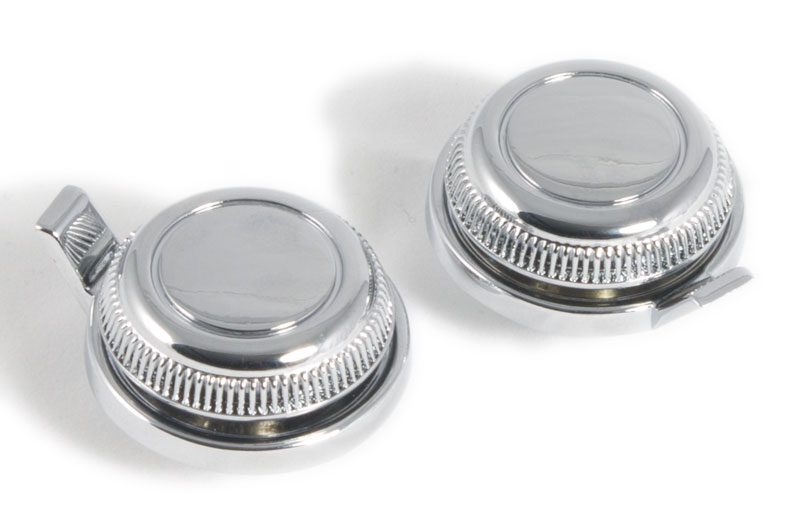
Editor Review : RetroSound Model One Classic Head Unit
How Is It Made?
This is the oddest, cutest, most specialised item of car front end electronics I have ever and am ever likely to see in an entire career. It looks like a spindle unit when assembled but is actually a sound-off entrants’ dream but for one thing. It is NOT an audiophile unit as it is at best trying to replace a glowing high quality cassette deck, or maybe an eight track tape deck, or just possibly, acting as a hidden source for a defunct 33rpm vinyl singles deck! But oh my, you can do more creative and smarty-pants install stuff with the RetroSound Model One than any other headunit in existence, or in history up to now.
What you get in the RetroSound Model One’s box does NOT include a front panel or knobs as this is so very specialised. You have to specify black or chrome finish to the ‘˜nose’ and then select the panel and knobs. Choice, as you will see if you follow the link, is wide. I had a black set of knobs and front panellery and set it up basically, without opening the very carefully selected baggie of washers and bolts and little open nuts to secure the unit in just about any attitude. The InfiniMount system has deep cunning and looks like they have been working on it for ages, with all the little flangey shapes and cut-outs to make it just right for this, that or the other dash. In fact the research into the classic cars, has to be part of the R&D cost of such a machine.
What it does include is the weirdest plug-in doodad I have ever seen.
This has three holes and a dangly jack plug as well as the umbilicus connector to a fat cord coming out of the back of the unit to make it part of the game. The three holes are an SD/MMC card slot for up to a 32GB SDHC card, a USB slot for sticks (but NOT iPlops) and a 3.5mm socket called Aux 2. Aux 1is the same type 3.5mm socket for stereo input from any device with a headphones out, via the right tip-ring-sleeve 3.5mm cord but is on the front of the unit. But get this, AUX 2 is actually a socket dangling upon a wire from the back of the unit. So, you either plug your MP3 player whatever into this unit via sticking the jack plug in the front, or you can stick it straight into the dangling socket-wire on the back. But here’s the oddly clever bit. You get TWO AUX inputs, technically one front and one back, but the dangly jack plug on the plug in unit has this clever job, that if you connect this to the rear AUX 2 input, that is when the front plug hole on the remote SD/USB box actually becomes live. I can tell you I actually had to RTFM to work this out and felt a bit of a tit. The 3.5mm jack socket input as a dual Aux is really cool, and making it such that you can either do it backstage out of sight, in the front of your unit, or else via the USB/SD card boxette (intended to be hidden flush under a panel by four tiny screws in any case) is elegant and thoughtful. It speaks of a whole approach, as does the happy encouragement to bend, shape or cut the InfiniMount brackets as need be, since this is design intent for maximum flexibility.
The Potentiometers in the remote spindle affairs were high quality and feel as solid as any I ever recall. They were just always inside the box before, was all.
Chrome Fascia plate: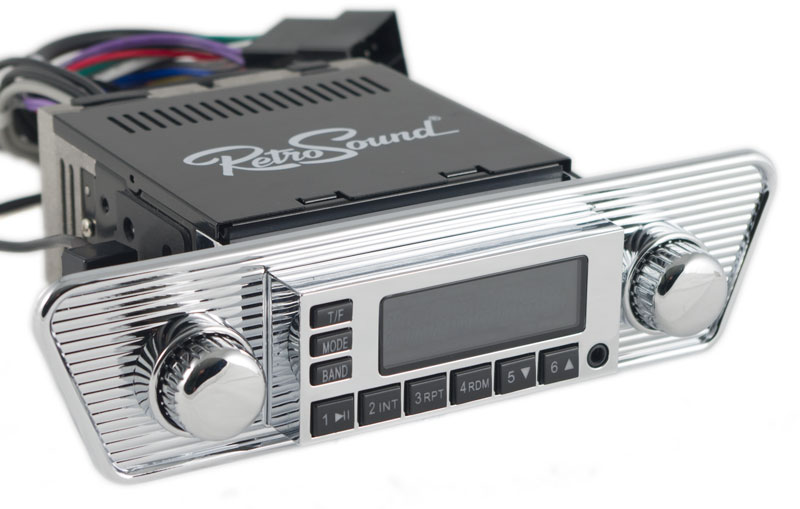
Here’s their own video about the clever install options:
http://www.youtube.com/watch?v=-IyXj-QTzc8
How Well Does It Work?
Wow! That’s as American as ‘˜Mom’s Apple Pie’ but the real point is about the flexibility of fitment and how it can be made to look cool in just about any car. The RF remote is an amazingly rare feature, which I utterly adored. It has on/off and all the navigation of the digital files tuff you will need upon it. Not having to point it like a torch is refreshing and you could picnic beside your open top car and play era-appropriate music from where you are sat nearby, without ever needing to get off your butt. Ideal lazy listen-while parked simple track-choosing.
I loved all the installation parts and can relate that the whole system is top quality and is a significant slice of the end user experience. The controls feel like solid yesteryear things. It feels classy.
Black Fascia Plate: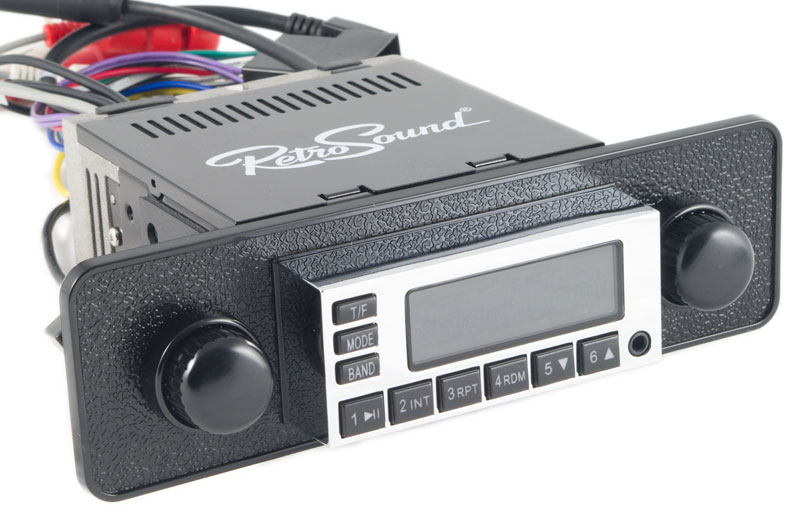
The unit also has a limited number of buttons upon it and these feel reasonably solid, offering up the functions you find duplicated on the remote, such as repeat and accessing the DSP. Said Digital Signal Processor offers some ambient effects like Classic, Rock and Pop (no likey!). There’s a rather blunt Loudness on/off control deep in the same menu, as is the chance to turn the beep on or off as and also to set volume levels when it powers up.
I stuffed a SD card in it with a slew of tunes and also the 8GB Sandisk ‘˜bean’ that is also stuffed with tunes. You can select the files easily enough, if not as slickly as with an Apple interface and the Album, Artist and Track name stuff scrolls across the screen. If you insert a card or a USB stick, it senses and switches input. The controls are all pretty easy to get a grip of but as it is a simple display, it isn’t a fussy process.
I found the sound to be clear and punchy and it felt good and loud, which I realised was in fact down to the slight compression of the files’ nature combined with an onboard op amp for the line drive to the RCAs that wasn’t high end. I would guess a simple signal to noise ratio for the audio section as no better than around 85dB like a SeVic unit. That said, check out the difference in the voltage of the signal input capability on the AUX input for the front versus rear. of the files’ nature combined with an onboard op amp for the line drive to the RCAs that wasn’t high end. I would guess a simple signal to noise ratio for the audio section as no better than around 85dB like a SeVic unit. That said, check out the difference in the voltage of the signal input capability on the AUX input for the front versus rear. You can put 2V of signal in the rear jack socket (the one that can be extended by plugging-in the lengthening system, to the front USB/SD box housing) whereas that’s only the standard 500mV for the front of the deck’s socket.
You can get a crisper result by keeping your file size nice and high and using a BIG storage medium but to fret about the SQ too much is to miss the point for the RF remote is world-beating brilliant! I now want a sixties E-Type Jag to take to Henley Regatta and we shall park by the Thames and play on-era Sixties swinging tunes!
But seriously, a brilliant idea, with a whole heap of excellent design nods to the purpose of fitting into older classic cars and bringing their music up to date. I gather they also make Neodymium speakers to fit in the same holes to improve sound from the ancient stock locations that often only allowed a speaker-of-the-then-tech to fit, i.e. tiny crappy Ferrite magnets. The speakers to go with these units also feature an under seat compact hidden woofer, so all sorts can be done. But for now, marvel at the deliciousness of the RetroSound Model One, it is unique and utterly brilliant.
Easy Talk Audio Recommended status. If you know anyone with a classic car….tell ‘˜em.
Overall 8.8
Sound Quality 7
Appearance/Display 10
Ease Of Use/HMI 7
Features 10
Value For Money 10
In A Nutshell
A fabulously specialised and rare creature, made to be compatible with fastidious classic car owners, yet allow them to play with modern formats. Superbly flexible, well designed, good to look at and use and a powerful jukebox to boot. What’s not to love?